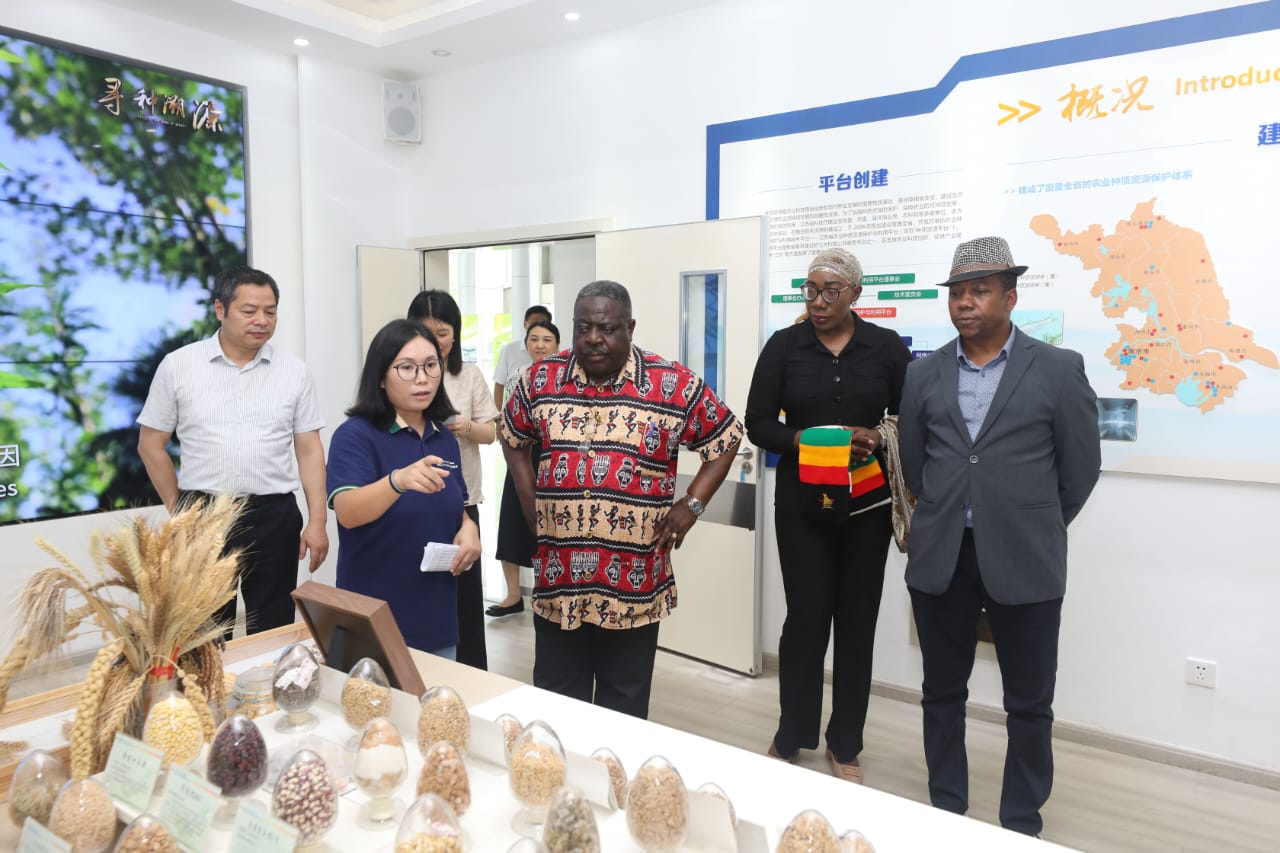Zimbabwe delegation on an Economic Affairs and Investment offensive in China to boost economic transformation and rural industrialization.
A Zimbabwe delegation has made positive engagements in the People's Republic of China to boost agricultural transformation and rural industrialization with mutual agreement on the development reached yesterday with the Jiangsu Academy of Agricultural Sciences (JAAS) in Nanjing.
Led by the ZANU-PF Secretary for Economic Affairs, Lt. Gen (Rtd) Dr. Engelbert Rugeje, the delegation held a meeting with officials from JAAS in Nanjing on 16th July 2025. Other members of the delegation are the ZANU PF Director for Economic Affairs, Hon Anastancia Ndhlovu and Mr K. Diza from the Zimbabwe Embassy in China. An investor Mr Su Xilong is also accompanying Gen Rugeje.
The meeting concluded positively, with JAAS officials showing a strong interest in pursuing collaborative projects in Zimbabwe with agriculture universities, colleges, experts including Professors.
Dr. Rugeje reiterated Zimbabwe’s dedication to inclusive economic growth driven by agriculture and production.
He said that it dovetails with President Mnangagwa’s development philosophy of “Leaving No One and No Place Behind.”
“As ZANU PF through our Government? We are adopting Smart Agriculture to make the agriculture sector more competitive, reliable, and resilient,” he said, adding:
“This digital shift saw us meeting the JAAS where we called for Chinese collaboration to introduce more advanced agricultural technologies in Zimbabwe.”
“Meanwhile, His Excellency President Mnangagwa’s administration is expecting agriculture to grow into a US$13,75 billion industry by 2025, as it is one of the key pillars of the National Development Strategy 1 (NDS 1), which runs from 2020 to 2025.
“ Initially, under the NDS-1, Government expected to attain a US$8,2 billion agricultural industry by 2025. However, through multiple interventions by ZANU PF through its Government, this mark was achieved before 2025, and saw the agricultural industry attaining US$9,9 billion agriculture economy by 31 December 2022.”
In line with NDS-1, the Agriculture and Food Systems Transformation Strategy (AFSTS) has a target to triple agriculture output by 2030.
Noteworthy is that, the AFSTS envisages to improve land use planning, increasing agricultural productivity, developing appropriate technologies, and ensuring sustainable development.
Meanwhile, agricultural production and sector development remains on a positive trajectory. The 2024/2025 agricultural season witnessed a significant improvement, with above-normal rainfall resulting in strong yields and a national cereal surplus. The President has also introduced several Presidential schemes that have grown the agriculture sector.
The invitation to JAAS includes collaboration in agricultural research, curriculum development, and student and expert exchanges—aimed at fostering innovation and productivity among the next generation of Zimbabwean farmers and scientists.
Zimbabwe continues to implement Presidential schemes aimed at empowering smallholder farmers and rural communities, including free input programs, fisheries, mechanization, and youth empowerment projects.These initiatives align with the nation’s broader goals of reducing poverty and promoting sustainable development in line with Vision 2030.
The ZANU PF government’s efforts in integrating ICT into agriculture aims to increase production, lower costs, and improve profitability throughout the whole value chain.
Sources close to discussions say at the meeting in China, there was mutual understanding to Zimbabwe’s dedication to agricultural research and education.
Since gaining independence in 1980, the ZANU PF government has set up various training institutions, including vocational centers, polytechnics, and universities like Marondera University of Agricultural Science and Technology (MUAST).
All 13 state universities now offer agriculture-related programs, strategically placed to fit the country’s diverse agro-ecological zones.
Zimbabwe is experiencing rapid growth in horticultural exports, especially blueberries from the Eastern Highlands.
Current exports are projected at 8,000 tonnes this year, with a goal of reaching 30,000 tonnes by 2030 under the Horticultural Recovery and Growth Plan (HRGP).
“There is immense potential in our agriculture sub-sectors—maize, wheat, cotton, livestock, poultry, and horticulture. These areas are ripe for investment and growth,” said Lt. Gen (Rtd) Dr. Rugeje encouraging foreign investors to join Zimbabwe’s agro-industrial revolution.
Zimbabwe continues to implement presidential schemes aimed at empowering smallholder farmers and rural communities, including free input programs, fisheries, mechanization, and youth empowerment projects.
Agriculture is central to this vision, as it supports Zimbabwe’s mostly rural population and drives employment, industry, and exports.
Agriculture supports over 60% of Zimbabweans, contributes 15% to GDP, and provides 63% of raw materials for the manufacturing sector.
With this strong foundation, the government has launched an ambitious development plan under the National Development Strategy 1 (NDS 1) in 2020.
Initially, the agriculture sector was projected to grow to a US$8.2 billion industry by 2025.
However, it exceeded expectations, reaching US$9.9 billion by December 2022.
The new target is set at US$13.75 billion, driven by interventions that include mechanization, food system changes, and climate-smart policies.
In the 2024/2025 agricultural season, Zimbabwe experienced above-average rainfall, resulting in high yields and a cereal surplus.
In 2024, the country recorded its highest-ever wheat harvest at 563,961 tonnes, surpassing the previous record of 467,000 tonnes.
This marks the third consecutive year of wheat self-sufficiency, reinforcing Zimbabwe’s status as an emerging agricultural powerhouse.
The Pfumvudza/Intwasa conservation farming method further supported rural resilience, helping communities deal with the impacts of El-Niño-related drought.
This strategy focuses on efficient resource use on small plots and has been recognized for improving household food security.
To modernize farming, Zimbabwe has adopted Smart Agriculture—a tech-driven approach that uses mobile apps for weather data, pest management, and market prices.
These initiatives align with the nation’s broader goals of reducing poverty and promoting sustainable development guided by President E.D Mnangagwa's Vision 2030.
As Zimbabwe seeks global partnerships, the message is clear: Zimbabwe is open for business.
Engaging with JAAS marks another significant step in the country’s ongoing efforts to reconnect with the world, signaling a future built on shared innovation, growth, and prosperity.
The delegation will go to Donghai Crystal City to expore other collaborations in value addition and beneficiation of various raw materials.
